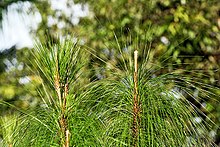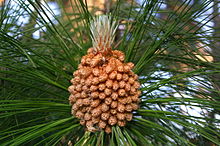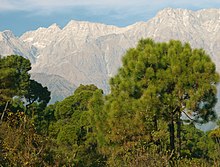Pinus roxburghii
| Pinus roxburghii | ||||||||||||
|---|---|---|---|---|---|---|---|---|---|---|---|---|

Pinus roxburghii |
||||||||||||
| Systematics | ||||||||||||
|
||||||||||||
| Scientific name | ||||||||||||
| Pinus roxburghii | ||||||||||||
| Coffin. |
Pinus roxburghii , also known as Emodi pine in German, is an evergreen conifer from the genus of pines ( Pinus ) with usually 25 to 30 centimeter long needles and 10 to 15 centimeter long seed cones. The natural distribution area is in the Himalayan region in the monsoon climate. The species is not considered endangered and is an important supplier of resin from which camphor is made. Railway sleepers are made from the wood.
description
Appearance
Pinus roxburghii grows as an evergreen tree , usually up to 30 meters, sometimes up to 50 or 55 meters high. The trunk is straight and columnar and has a diameter of up to 300 centimeters at chest height , but mostly up to 100 centimeters. The trunk bark is red-brown, thick in older trees, deeply furrowed along its length and breaks into elongated, scale-shaped plates that are gray-brown under the influence of weathering and have brown and reddish shades. The branches are horizontal or upright and form an open, dome-shaped crown in older trees. The needled branches are thin or thick, pale gray or light brown and covered with leaf-shaped, brown lower leaves that remain on the tree for several years and the tips of which later curl up.
Buds and needles
The brown winter buds are small, egg-shaped and not resinous. The needles grow in threes in a permanent, 25 to 30 millimeter long, basal needle sheath at the ends of the branches and stay on the tree for one to two years. They are light green, straight and slightly hanging, thin and flexible, 25 to 30 sometimes up to 35 centimeters long and 1.2 to 1.7 millimeters wide, with a broad triangular cross-section. The edge of the needle is finely sawn, the end pointed to pointed. There are fine stomata lines on all needle sides . Two resin channels running in the middle are formed for each needle .
Cones and seeds
The pollen cones grow in a spiral at the base of young shoots. They are ovate-oblong and 13 to 15 millimeters long. The seed cones grow individually or in whorls of two to five on sturdy branches. They are short-stalked, broadly ovate to ovoid-conical, 10 to 15, rarely 20 centimeters long and are 7 to 12 centimeters wide when closed. They open only a little after several years and then have a maximum diameter of 13 centimeters. The seed scales are elongated, woody and inelastic. The apophysis is pronounced, thick, conical with a rhombic to irregular pentagonal base, sharply keeled transversely, partly strongly bent back, smooth and shiny yellowish brown or grayish brown. The umbo is triangular, blunt and unreinforced. The seeds are obovate, 8 to 12 sometimes to 15 millimeters long and slightly flattened. The seed wing is 20 to 25 millimeters long, 8 to 10 millimeters wide, translucent and lighter brown than the seed. The seeds ripen from October to November.
The number of chromosomes is 2n = 24.
Distribution, ecology and endangerment

The natural range of Pinus roxburghii extends from Afghanistan and Pakistan, over Tibet , Bhutan and Nepal to Myanmar and into the Indian states of Arunachal Pradesh , Himachal Pradesh , Jammu and Kashmir , Sikkim and Uttar Pradesh . It grows at heights of 400 to 2300 meters, isolated specimens can even be found up to 2500 meters. The species is particularly common and widespread in the outer valleys of the Himalayas and its foothills, which run in north-south direction, and forms pure populations especially on dry, fire-prone slopes. Mature trees are comparatively fire resistant, and areas destroyed by fire are populated again very quickly ( pioneer tree species ). It loses almost all of its needles during longer periods of drought. Both deep soils and bare rocks serve as subsoil. The distribution area is in the monsoon belt with extensive summer rain. At higher altitudes, Pinus roxburghii grows together with the Himalayan cedar ( Cedrus deodara ) and the teardrop pine ( Pinus wallichiana ), towards the tree line together with representatives of the firs ( Abies ). Deciduous trees such as the oak Quercus incana , Schima wallichii and Rhododendron arboreum dominate at lower altitudes . In the lowest areas of their range, their occurrence is limited to rocky slopes facing north or east. The distribution area is assigned to winter hardiness zone 9 with mean annual minimum temperatures of −6.6 to −1.2 degrees Celsius (20 to 30 degrees Fahrenheit ).
In the Red List of the IUCN is Pinus roxburghii classified as endangered ( "Lower Risk / least concern"). However, it should be noted that a reassessment is pending.
Systematics and research history
Pinus roxburghii is a species from the genus of pines ( Pinus ), in which it is assigned to the subgenus Pinus , section Pinus and subsection Pinaster . It was first scientifically described in 1897 by Charles Sprague Sargent in The Silva of North America . The generic name Pinus was already used by the Romans for several types of pine. The specific epithet roxburghii is reminiscent of the Scottish botanist William Roxburgh (1751-1815), who worked for the British East India Company and was director of the Botanical Garden of Calcutta . A synonym of the species is Pinus longifolia Roxb. ex Lamb.
use
resin
Pinus roxburghii is used for resin extraction throughout the Himalayan region, but particularly in the north-west of India. Resin extraction goes back to the British, who used the resin to produce turpentine and other products that were used to maintain their ships. The Indian Forest Department was created in 1888 to maintain the income . Even after decolonization , the species remained the main source of turpentine in India, but production fell significantly due to poor management of the forests and destructive gumming of trees. The situation has now improved, but today (as of 2010) the resin from Pinus roxburghii is mostly processed into camphor or used for medical purposes.
Wood
The wood is treated with a protective agent and is often used for the production of railway sleepers, serves as construction timber and is used in joinery and joinery. It is also processed into pulp for the paper industry.
Other uses
The bark contains 10 to 14 percent of tannins , which are used to tan leather and to dye wood orange. The seeds are edible, but not tasty. The needles are used as litter or mixed with the manure used as fertilizer. The species is rarely cultivated outside of India and Pakistan, but was introduced as a forest tree in South Africa. Sometimes it is also used as an ornamental tree, especially in the Mediterranean area. Although it is not exposed to frost in its natural range, it is to a small extent frost-resistant.
swell
literature
- Aljos Farjon: A Handbook of the World's Conifers . tape 2 . Brill, Leiden-Boston 2010, ISBN 90-04-17718-3 , pp. 754-755 .
- Wu Zheng-yi, Peter H. Raven (Ed.): Flora of China . Volume 4: Cycadaceae through Fagaceae . Science Press / Missouri Botanical Garden Press, Beijing / St. Louis 1999, ISBN 0-915279-70-3 , pp. 14 (English).
- Helmut Genaust: Etymological dictionary of botanical plant names. 3rd, completely revised and expanded edition. Nikol, Hamburg 2005, ISBN 3-937872-16-7 , p. 487 (reprint from 1996).
Individual evidence
- ↑ German name after Robert Zander : Zander. Concise dictionary of plant names. Edited by Walter Erhardt , Erich Götz, Nils Bödeker, Siegmund Seybold . 17th edition. Eugen Ulmer, Stuttgart 2002, ISBN 3-8001-3573-6 , quoted from Pinus roxburghii. In: Germplasm Resources Information Network (GRIN). United States Department of Agriculture, accessed April 7, 2013 .
- ↑ a b c Liguo Fu, Nan Li, Thomas S. Elias, Robert R. Mill: Pinus roxburghii , in Flora of China , Volume 4, p. 14
- ↑ a b c d e Aljos Farjon: A Handbook of the World's Conifers , Volume 2, p. 754
- ↑ Pinus roxburghii at Tropicos.org. Missouri Botanical Garden, St. Louis, accessed April 7, 2013.
- ↑ a b Pinus roxburghii. In: Germplasm Resources Information Network (GRIN). United States Department of Agriculture, accessed April 7, 2013 .
- ↑ Christopher J. Earle: Pinus roxburghii. In: The Gymnosperm Database. www.conifers.org, March 18, 2012, accessed April 7, 2013 .
- ↑ Pinus roxburghii in the endangered Red List species the IUCN 2012. Posted by: Conifer Specialist Group, 1998. Accessed April 7, 2013.
- ↑ Exactly: Etymological dictionary of botanical plant names p. 487
- ↑ Pinus longifolia Roxb. ex Lamb. . In: Germplasm Resources Information Network (GRIN). United States Department of Agriculture, accessed April 7, 2013 .
- ↑ a b c Aljos Farjon: A Handbook of the World's Conifers , Volume 2, p. 755
Web links
- Pinus roxburghii. In: The Plant List. Retrieved April 7, 2013 .
- Pinus roxburghii at Plants For A Future . Retrieved April 7, 2013.


